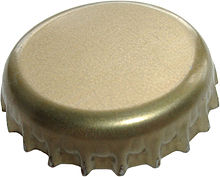- Crown cork
-
The crown cork (also known as a crown cap or just a crown), the first form of bottle cap, was invented by William Painter in 1891 in Baltimore. The company making it was originally called the Bottle Seal Company, but it changed its name with the almost immediate success of the crown cork to the Crown Cork and Seal Company. It still informally goes by that name, but is officially Crown Holdings. The Patent was granted in 1892, as US patent # 468,258.
The crown cork was the first highly successful disposable product (it can be resealed but not easily). This inspired King C. Gillette to invent the disposable razor when he was a salesman for the Crown Cork Company. The company still survives, producing many forms of packaging.[1]
Prior to the invention of the crown cork bottle stopper, soda bottles had ordinary cork bottle stoppers and often had rounded bottoms so they could not be stored standing upright. The reason for this is corks have a tendency to dry out and shrink, which allows the gas pressure in the bottle to cause the cork to "pop." Storing bottles on their side prevents the corks from drying out and "popping." After the invention of the crown cork bottle stopper, this problem was eliminated and soda bottles could be stored standing upright.[2]
Crown corks are collected by people around the world who admire the variety of designs and relative ease of storage.[3] [4] Collectors tend to prefer the term crown cap over corks. In Mexico these are called Corcholatas, in Spain as well as in South America the name chapas is used, while in the Philippines the term tansan is used.
Contents
Popular culture
- Crown cork bottle caps are prominently featured as currency in the Fallout series of video games.
- Crown corks are also used as a currency in the Scrooge McDuck story "Tralla La" (Carl Barks, 1954) and make an appearance in the sequel, "Return to Xanadu" (Keno Don Rosa, 1991).
- Crown corks are "treasures" the player must collect in Pikmin 2, known as Bottle caps.
See also
References
- ^ Crown Brand-Building Packaging: Crown History
- ^ Nickell, Joe (2011). "'Pop' Culture: Patent Medicine Becomes Soda Drinks". Skeptical Inquirer (Committee for Skeptical Inquiry) 35 (1): 14–17.
- ^ The Crowncap Collectors Society International
- ^ Crowncaps.Info - Crown cap Central for Crown cap collectors
External links
- U.S. Patent 468,226
- U.S. Patent 468,258
- Bottle Cap Index
- Davide's Crown Caps Homepage
- Collection of Alex and Gemma

This article about an item of drinkware or tool used in preparation or serving of drink is a stub. You can help Wikipedia by expanding it.

